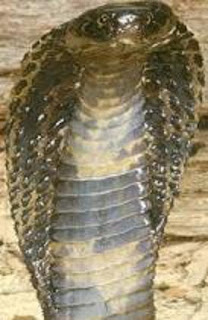 |
| Cobra Head. |
The cobra head sign is characterized by bulbous dilatation of the distal end of the ureter with a surrounding radiolucent halo, seen within the contrast material–enhanced bladder on intravenous urograms.
The cobra head sign is classically seen with an intravesical ureterocele. This type of ureterocele is also termed orthotopic, since it arises from a ureter with a normal insertion into the trigone. The term ureterocele denotes a cystic ballooning of the distal end of the ureter. What causes ureterocele is not clear. However, the anatomic basis and the mechanism of formation described in the literature is as follows: An intravesical ureterocele results from the prolapse of the mucosa of the terminal segment of the ureter through the ureterovesical orifice into the bladder. This prolapsed ureteral mucosa carries with it a portion of the continuous sheet of the bladder mucosa around the orifice. The prolapsed segment thus has a wall that consists of a thin layer of muscle and collagen interposed between the bladder uroepithelium and the ureter uroepithelium. Since the terminal ureteral orifice is usually narrowed and partially obstructed, and since there is no muscle support for the double mucosal walls of the prolapsed segment, it dilates. This dilated segment fills with urine and protrudes into the bladder.
 |
Frontal urogram after intravenous contrast material administration shows bulbous dilatation of the distal end of the left ureter. Note the surrounding radiolucent halo (arrows).
|
At intravenous urography, the lumen of the ureterocele is usually filled with contrast material and is surrounded by opacified urine in the bladder. Since the double mucosal wall of the ureterocele is visible as a thin lucent line or halo surrounding its lumen, the ureterocele is outlined, giving the appearance of a cobra head.
In conclusion, the cobra head sign, when present, allows DIAGNOSIS of a URETEROCELE. However, causes of pseudoureterocele, such as a tumor or calculus, need to be ruled out on the basis of the appearance of the surrounding radiolucent halo.
 This view is
particularly useful to show the pars interarticularis region and the apophyseal
joints. Note that the pars interarticularis is a purely radiological term, its
equivalent anatomically being the anterior part of the lamina. The oblique view
causes a certain well- known appearance of a Scottie dog: the dog's collar is
the pars interarticularis, the eye is the pedicle, the nose is the transverse
process and the ear is the superior articular facet. Defects of ossification of
the pars may lead to spondylolisthesis. Again, as in the cervical spine, facet
articulation disorders can be seen.
This view is
particularly useful to show the pars interarticularis region and the apophyseal
joints. Note that the pars interarticularis is a purely radiological term, its
equivalent anatomically being the anterior part of the lamina. The oblique view
causes a certain well- known appearance of a Scottie dog: the dog's collar is
the pars interarticularis, the eye is the pedicle, the nose is the transverse
process and the ear is the superior articular facet. Defects of ossification of
the pars may lead to spondylolisthesis. Again, as in the cervical spine, facet
articulation disorders can be seen. 



